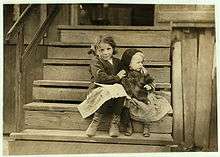Sister
A sister is the female sibling.
Overview


The term sister comes from Old Norse systir which itself derives from Proto-Germanic *swestēr, both of whom have the same meaning, i.e. sister. Some studies have found that sisters display more traits indicating jealousy around their siblings than their male counterparts, brothers.[1] In some cultures, sisters are afforded a role of being under the protection by male siblings, especially older brothers from issues ranging from bullies or sexual advances by womanizers.[2] In some quarters the term sister has gradually broadened its colloquial meaning to include individuals stipulating kinship.[3] In response, in order to avoid equivocation, some publishers prefer the usage of female sibling over sister.[4]
Studies
Various studies have shown that an older sister is likely to give a varied gender role to their younger siblings as well as being more likely to develop a close bond with their younger siblings.[5] Older sisters are more likely to play with their younger siblings.[6] Younger siblings display a more needy behavior when in close proximity to their older sister[7] and are more likely to be tolerant of an older sisters bad behavior.[8] Boys with only an older sister are more likely to display stereotypically male behavior, and such masculine boys increased their masculine behavior with the more sisters they have.[9] The reverse is true for young boys with several sisters, as they tend to be feminine, however they outgrow this by the time they approach pubescence.[10] Boys with older sisters were less likely to be delinquent or have emotional and behavioral disorders.[11] A younger sister is less likely to be scolded by older siblings than a younger brother.[12] The most common recreational activity between older brother/younger sister pairs was art drawing.[5] Some studies also found a correlation between having an older sister and constructive discussions about safe sexual practises.[13]
Famous sisters
- Awan and Azura, daughters of Adam and Eve
- Mary I of England and Elizabeth I of England, royalty
- Caroline, Princess of Hanover and Princess Stéphanie of Monaco
- Tamar Braxton, Toni Braxton, Towanda Braxton, Traci Braxton, and Trina Braxton, known as The Braxtons
- Jacqueline Bouvier Kennedy Onassis and Lee Radziwill
- Mary and Eliza Chulkhurst, conjoined twins known as the Biddenden Maids
- Jackie Collins, author and Joan Collins, actress
- Annie Elizabeth Delany and Sarah Louise Delany, the subjects of Having Our Say (1993)
- Hilary Duff, actress, and Haylie Duff, singer
- Eva Gabor, Magda Gabor, and Zsa Zsa Gabor, actresses and singers
- Melissa Gilbert and Sara Gilbert, actresses
- Ilona and Judit Gófitz, conjoined twins
- Mariel Hemingway and Margaux Hemingway
- Paris Hilton and Nicky Hilton, socialites
- Maureen "Rebbie" Jackson, La Toya Jackson, and Janet Jackson, members of the Jackson family
- Khloe Kardashian, Kim Kardashian, Kourtney Mary Kardashian, reality TV stars
- Rose Marie "Rosemary" Kennedy, Kathleen Agnes "Kick" Kennedy Cavendish, Eunice Mary Kennedy Shriver, Patricia Helen "Pat" Kennedy Lawford, and Jean Ann Kennedy Smith, members of the Kennedy family
- Beyoncé and Solange Knowles
- Caroline Manzo and Dina Manzo, reality TV stars who married brothers Albert and Tommy Manzo
- Millie and Christine McCoy, conjoined twins
- Grand Duchess Olga Nikolaevna of Russia, Grand Duchess Tatiana Nikolaevna of Russia, Grand Duchess Maria Nikolaevna of Russia and Grand Duchess Anastasia Nikolaevna of Russia, also known by the acronym OTMA, daughters of the last autocratic ruler of the Russian Empire
- Ashley Olsen and Mary-Kate Olsen, also known as "The Olsen Twins", twin actresses and fashion designers
- Anita Pointer, Bonnie Pointer, Issa Pointer, June Pointer, Ruth Pointer, and Sadako Pointer, at various times members of the singing group known as The Pointer Sisters
- Kim Richards and Kyle Richards, actresses and reality TV stars
- Rita and Cristina of Parodi of Sardinia, conjoined twins
- Jessica Simpson and Ashlee Simpson, singer-songwriters
- Britney Spears, singer, and Jamie Lynn Spears, actress
- Johanna, Martina, Maria, Hedwig, Agathe, Rosmarie, and Eleonore ("Lorli") Von Trapp, daughters of Georg von Trapp
- Priscilla "CeCe" Winans, Angelique Winans-Caldwell, Debra Renee Winans-Lowe, members of Winans family of singers and musicians
Fictional works about sisters
Films
- What Ever Happened to Baby Jane? (1962 film)
- Hannah and Her Sisters (1986), film
- Hanging Up (2000), film
Literature
- Laura Lee Hope's Bobbsey Twins novels, which included two sets of fraternal twins: 12-year-old Nan and Bert, and six-year-old Flossie and Freddie
- In Her Shoes (2002), novel
Television
- Hope & Faith, American sitcom
- Sisters (TV series)
- What I Like About You, TV series
See also
References
- ↑ Volling, B. L.; McElwain, N.L.; Miller, A.L. (2002). "Emotion Regulation in Context: The Jealousy Complex between Young Siblings and its Relations with Child and Family Characteristics". Child Development 73 (2): 581–600.
- ↑ Handbook of Cultural Psychiatry - Page 67, Wen-Shing Tseng - 2001
- ↑ van der Burghe, Pierre (1987). The Ethnic Phenomenon. p. 27.
- ↑ Olshewsky, Thomas (1969). Problems in the philosophy of language. p. 286.
- 1 2 Gender - Page 53, Leanne Franklin - 2012
- ↑ Play from Birth to Twelve: Contexts, Perspectives, and Meanings, , Doris Bergen 2015
- ↑ Sisters and Brothers - Page 78, Judy Dunn - 1985
- ↑ The Corsini Encyclopedia of Psychology and Behavioral Science, Volume 4, Charles B. Nemeroff, 2002 p 1524
- ↑ Gender Development - Page 300,Lynn S. Liben - 2009
- ↑ Gender Development, Sheri A. Berenbaum, 2013
- ↑ Advances in Child Development and Behavior, Volume 26, p 161, 1996
- ↑ He & she: how children develop their sex role identity, Wendy Schempp Matthews - 1979 p 162
- ↑ Handbook of Adolescent Psychology, Contextual Influences on Adolescent Development, Laurence Steinberg, PhD - 2009 p 61
External links
-
 The dictionary definition of sister at Wiktionary
The dictionary definition of sister at Wiktionary